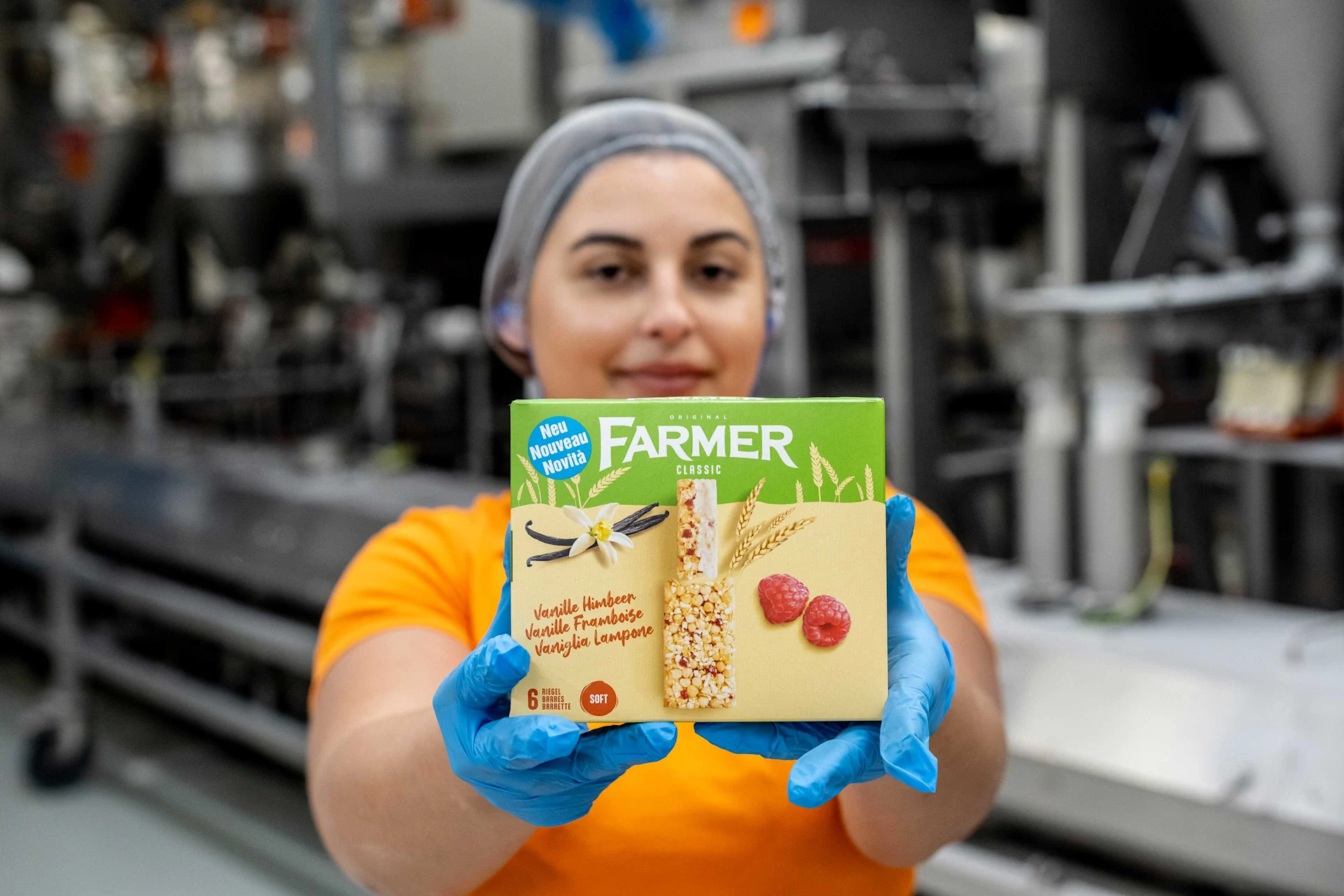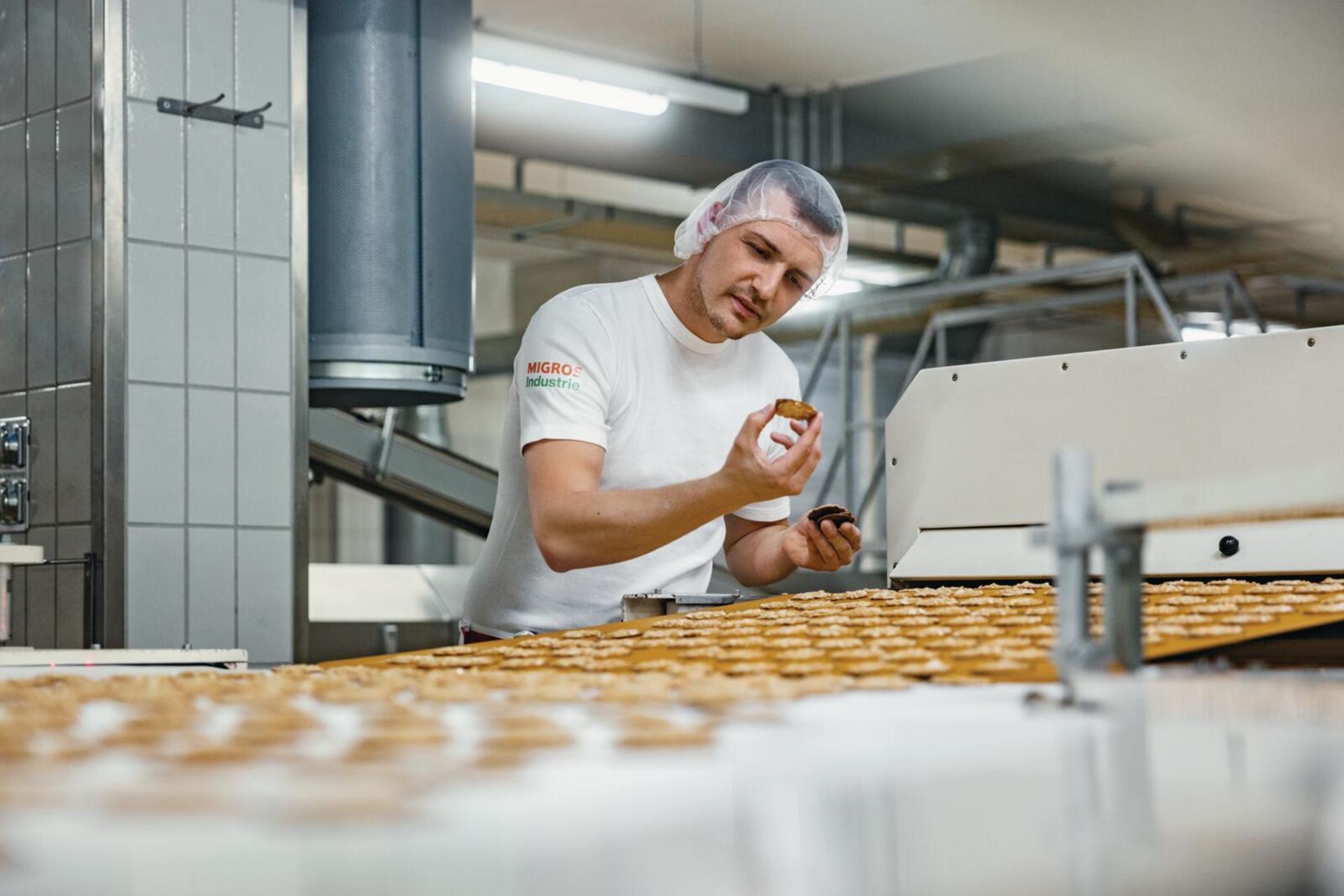
Migros Industrie
How farmer bars are made
The new vanilla and raspberry flavour is now on sale. We visited the factory where the bars are made.
navigation

Climate & energy
From cookies to cosiness: the Migros factory in Meilen produces not only biscuits, Farmer bars and Blévita, but also energy that is used to heat homes in the local community.
At the Migros plant in Meilen, cinnamon stars and Milanese biscuits are rolling off the production line. Aside from exuding a wonderful aroma, they also help to heat homes in the lakeside community near Zurich. How this works isn't visible to the naked eye because it takes place below ground: waste heat from the plant is fed to the houses along a network of underground pipes.
The idea of what is known as 'district heating' is both clever and sustainable. Instead of being dispersed into the air unused, heat that is generated at a factory - in this case the Migros Delica production plant - is put to good use. Waste heat is created when heat is extracted from a room or product in order to lower the temperature.
"You can't generate cold. You can only take heat away and put it somewhere else," explains Markus Müller, the man responsible for energy management at Delica. At the Migros plant in Meilen, the heat ends up at the energy centre of Energie 360°, a Swiss company that specialises in sustainable energy solutions. This facility was built specifically on a plot of land on the Delica site. Here the heat is brought to the required temperature level using heat pumps and then fed into the local pipe system.
Work on the centre began in summer 2022. For the past year, the first buildings have been heated using waste heat from the biscuit factory. The next stage of construction work is already under way, with the aim of connecting a total of 100 properties. These include detached houses, large apartment blocks and company premises. The infrastructure is being installed and operated by Energie 360°, which has invested CHF 20 million in the project.
Connecting to the Meilen energy network means the buildings can reduce their CO2 emissions by 3,000 tonnes a year. "That's the equivalent of saving more than a million litres of heating oil," says Lars Strickler, Head of Communications at Energie 360°. District heating provides the lucky residents with additional benefits too. For example, not only do they save on CO2 tax, they can also wave goodbye to the maintenance costs and effort involved in operating a fossil-fuel heating system, as well as chimney sweeping, fire inspections and repairs. "Energy costs also fluctuate much less if we use local waste heat rather than heating with fossil fuels, where costs also depend on external factors," Strickler explains.
Connecting to the energy network saves the buildings more than a million litres of heating oil.
In the warmer months, when the houses don't need heating, waste process heat from the factory is used to produce hot water for private households. However, much more waste heat is generated in summer than in winter because ice cream production is running at full tilt. Ice cream needs to be very cold - so a lot of heat has to be removed. Not only must refrigeration systems be cooled for storing fresh foods, like eggs, milk, cream and butter, but air conditioning systems are also running at full speed to prevent the production halls getting too hot.
Here's where lake water comes into play. Water from the depths of Lake Zurich at a temperature of just 7°C is circulated through the factory's air conditioning system. It absorbs ambient heat, reaching a temperature of up to 14-25°C. The unused warmed water is channelled back into Lake Zurich in the summer, with great care being taken to ensure the water around the pipe outlet doesn't get too hot and endanger fish.
The refrigeration systems have also been cooled using lake water for almost four years. This has enabled the Meilen site to slash its consumption of synthetic refrigerants - i.e. chemically produced substances - by three quarters in one fell swoop. That's advantageous because refrigerants are highly flammable and therefore pose occupational risks. If there was a leak, vast quantities of greenhouse gas could also escape.
Unfortunately, it isn't yet technologically feasible to keep surplus waste heat from the warm summer months until the following winter. That's because storing heat would need an enormous amount of space. In the case of hot water, this would require huge tanks. And even that probably wouldn't be enough because even the best insulation available today can't store heat until winter.
However, cold winter air is currently cooling the factory's halls while our Christmas biscuits are baking inside. Their energy will soon reach people in two ways: through the ground and via people's stomachs.
Discover exciting stories about all aspects of Migros, our commitment and the people behind it. We also provide practical advice for everyday life.